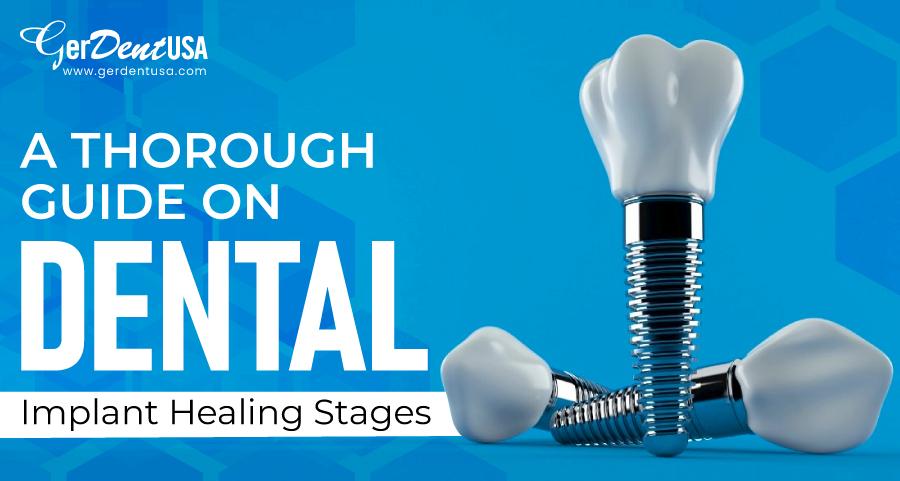Lots of people with missing teeth go for dental implants as a way to fix the problem. The American Academy of Implant Dentistry says that every year, about 15 million Americans get bridge and crown replacements for their missing teeth to ease tooth pain and improve their oral health
Dental implants may seem complicated, but it is an efficient procedure with a success rate of 95%. Tooth restorative procedures are beneficial to preserve the natural bone and support adjacent teeth. However, dental implant healing stages are quite lengthy and time taking.
It requires various dental visits, checkups, and appropriate treatments. We are going to discuss the whole healing process in detail. Keep on reading!
What Are the Dental Implant Healing Stages?
The healing process varies according to the type of implant the patient has undergone. However, some factors influence the recovery time, including the number of teeth replaced, patient age, and health of the underlying tissues and jawbone. In most cases, patients undergo pre and post-implantation, abutment, and crown placement. Here are the details of the following stages.
1. Prior To Implantation
The primary healing stages of implants include bone grafting or tooth extraction procedures.
-
Bone Grafting
Before starting the tooth implant, dental experts first assess the patient’s jawbone health. In this context, they determine whether your jawbone is suitable for the implant or not. In case of insufficient jawbone thickness, dentists suggest sinus lifting or bone grafting, which are whole separate procedures.
So, the first stage of the dental implant healing stages timeline is from 2 weeks to a month. Dentists schedule the implant procedure when the bone graft is completely fused with the bone.
-
Tooth Extraction
Another possibility is that the patient has a damaged or faulty tooth that needs to be removed before the placement of the implant. The site of the extracted tooth takes up to 10 weeks until it fully gets recovered. During this time, you may need to wait for the area to get ready for the implant.
-
Direct Implant
In most cases, dentists immediately begin the implant procedure without any additional requirements. However, this is only possible if the patient has healthy gums, no decayed or damaged teeth, and sufficient jawbone density. Otherwise, the patient has to undergo the bone grafting or extraction process to get a successful dental implant.
2. After Implantation
Dentists make a small cut in the gum tissues to expose the area where the implant is required to place. This cut will expose the underlying jawbone of the dental surgical site. Following that, dentists drill the hole in the place to insert the implant metal post. This post will serve as the root of the missing tooth, which the dentist sutures and covers with gauze. Now there are two recovery stages after the implant.
-
Healing of Surgical Site
After the successful placement of the implant, the surgical site takes up to 2 weeks until it fully gets healed. Following the dental expert’s instructions properly is necessary to speed up the recovery time. The aftercare instructions include the following:
- Alteration in the patient’s diet.
- Resting head in elevated positions.
- Use saltwater rinse.
During the implant healing process, patients also need to make several changes in their oral cleaning routines. Keeping the mouth clean reduces the risks of infections. For this purpose, brushing twice a day can help speed up the process. Use soft braces and bristle toothbrushes for cleaning purposes. Also, avoid direct brushing over the surgical site to prevent the risk of bleeding or any other damage.
-
Osseointegration
Osseointegration is the second step of the dental implant healing stages, which can take up to 8 to 9 months. However, this is not the specific duration and can vary according to the type and number of implants and the patient's immune system. When the implant metal post fuses with the jawbone, it creates a stable base for the abutment restoration.
3. Abutment Placement
Abutment placement is the second minor surgical step of the implant procedure. Dentists perform it when the implant has completely fused with the jawbone. During this process, the dentist opens the gum tissues in order to expose the implant post. After that, they place the abutments and close the gum tissues while keeping the implant open.
This stage of dental implant healing might take around a week to a month. During this period, the patient may experience discomfort due to gum swelling. Therefore, dental experts provide the appropriate painkillers to relieve the pain. Applying ice to the side may also help reduce inflammation.
After this stage, the patient’s surgical area is ready for restorative placement.
4. Restorative Placement
When your gums start healing, it is time to go to the dentist again for the last step of the dental implant. During the final restoration stage, dentists take impressions of the teeth surrounding the surgical implant site and the abutment. These impressions ensure the perfect match of dental restorations with natural teeth.
Laboratories take up to 2 weeks for the fabrication of the crown. After this, dentists place the dental prosthesis on the abutment to connect it to the tooth implant rod. It will give the implant and aesthetic appearance that is similar to your natural teeth.
Essential Follow-Ups for Efficient Recovery
Proper care of the implant is as important as your natural teeth. Patients need to follow some essential instructions during the dental implant healing stages. Following the dentist’s instructions to take care of the implant routinely will speed up the healing process and result in the efficient recovery of patients. Here are some important instructions:
- Dental surgeons often recommend taking much rest during the healing process to lower the severe impact on dental health due to physical insertion.
- It is essential to follow the dentist's instructions, such as avoiding smoking, eating junk hard or crunchy food, or anything that enhances stress on your tooth implant post-surgery.
- Blood clotting around the implant site is a natural healing process that requires protection. For this, adopt a gentle cleaning process, such as using salt water and mouthwash during the initial recovery days.
- Dentists prescribe some medications to relieve the patient’s swelling or inflammation. Taking those medications according to instructions will significantly reduce patients’ discomfort during the healing stages.
- Applying ice on the surgical sites will significantly reduce the intense pains as it will give relief to the soft tissues during healing. Besides, if the pain becomes unbearable, patients should go for dentists’ instructions.
Wrapping Up!
There are many factors that influence the dental implant healing stages. Different patients have varying implant recovery timelines depending on the type of implant and the patient’s oral condition.
This article is helpful for you to understand the critical stages of implant recovery. You may learn more about implants by visiting GerDentUSA. We provide comprehensive information about the dental implant procedure. Have a look at these!


